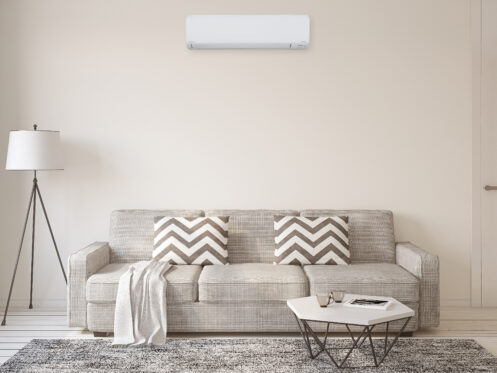Mini-split AC systems, also known as ductless mini-splits, can be extremely useful for supplementing your existing air conditioning and overcoming hot spots in your home. This type of system works just like central air conditioning except for using individual air handlers in certain rooms.
Each air handler cools the surrounding area instead of the system cooling the entire house. In this article, we’ll explore some of the places in your home where you may want to consider installing a mini-split. We’ll also look at some of the factors to consider when choosing the location for the indoor and outdoor parts of the system.
Bedrooms
One of the most common uses for a mini-split AC system is to add additional cooling to bedrooms. You could add one to each bedroom if you choose a zoned system with multiple indoor air handler units. This allows every person in the home to keep their bedroom at whatever temperature they wish since each unit can be controlled independently.
Any Rooms on an Upper Floor
A multi-story home’s upper floors almost always stay somewhat warmer than the ground floor. This is mainly because of heat rises but also because most homes’ thermostats are on the main level or ground floor. That means the central AC system will always shut off whenever the main floor is cool, and the system may never run long enough to cool the upper floors fully. Installing mini-split air handlers in rooms on the upper floor is another great option for ensuring that all parts of your home stay sufficiently cool and comfortable.
Rooms With Skylights or Large Windows
Any rooms with skylights or large windows also tend to be warmer due to all of the heat gain they receive from the sun. This is yet another situation where a mini-split can improve comfort since it will help to overcome this heat gain.
Additions
One of the best uses of a mini-split system is if you’re putting an addition onto your home. While you could connect the addition to your central AC system, installing a mini-split will usually be much easier and less expensive. The reason is that you would normally need to upgrade to a larger central AC unit whenever you’re increasing your home’s size. As such, the only situation where this would really make much sense is if you already need to replace your existing AC.
Garage
Many people use their garages for other purposes besides parking their vehicles, such as a home gym or workshop. However, you should never connect a garage to a central AC system due to the risk of it pulling carbon monoxide and other pollutants into the home. Installing a mini-split system for your garage is an easy way to keep it cool without negatively impacting your home’s indoor air quality.
Factors To Consider When Placing the Indoor Unit
Choosing the right location within a room for the mini-split air handler unit is crucial for ensuring the system functions efficiently and provides effective cooling. Although you can mount the air handler on the floor or have it recessed into the ceiling, it will work best when it is fairly high up on the wall. Generally speaking, you want around two feet of clearance between the unit and the ceiling. If it is too low, it won’t be very effective since it won’t be able to draw in all the heat that rises and collects near the ceiling. Too high is better than too low, but it will still lead to you not noticing the cool air it puts out nearly as much.
The air handler should also be mounted on a perimeter or exterior wall if possible. Part of the reason is that connecting it to the outdoor unit is much easier. That said, the main reason is that there is a direct path for the condensate drain line so that the unit can drain outside. You can put it on an interior wall if necessary, but you will usually need to install a condensate pump.
It’s also best to choose a location away from a TV, lights, and any other potential sources of heat. Anything that gives off heat can interfere with the unit’s ability to read the room’s temperature correctly. This can lead to the unit running more than it needs to and wasting energy. This issue is also why you should try to choose a location that doesn’t receive direct sunlight.
If you’re installing it in a larger room, you should choose a more central location that evenly distributes air throughout the room. Otherwise, one part of the room may remain warmer than you want.
Aesthetics can also be an important consideration when choosing the location for the air handler. This means you may want to consider your décor and how the unit will fit in with the room. If aesthetics are a concern, you should think about symmetry and try to have the unit centered on whichever wall you choose.
Choosing the Best Location for the Outdoor Unit
The outdoor part of a mini-split system is usually mounted next to the house on a composite or concrete pad since it needs to be fully level to work properly. That said, you could use brackets to mount it to the side of the house or even put it on your roof.
Most systems also require that the outdoor unit is no more than 100 to 150 feet away from the indoor air handler. However, it’s always best to choose a location that is as close to the indoor unit as possible. This is because the system’s efficiency can decrease the farther away the two units are from each other.
Choosing a unit that is mostly shaded or at least doesn’t receive lots of direct sunlight during the hottest part of the day will also help the system work more efficiently. If you don’t have a suitable shady area, you could install an awning above the unit to provide shade. You also need to choose a fairly open location away from shrubs or anything else that could interfere with the unit receiving proper airflow. Two feet of clearance around the unit is generally the minimum requirement.
One last thing to consider is accessibility since you want to make sure that a technician can easily service and repair the unit as needed. This is also true for the indoor unit so that you can change the air filter, and a technician can easily service it.
JW Plumbing, Heating and Air has been helping residents of the Los Angeles area with their home comfort needs since 2006. If you’re considering a mini-split AC for your home, we can help you choose the right location and find a system that best meets your needs. We install central ACs, heat pumps, and furnaces and offer professional HVAC maintenance and repairs. For more information on your options for mini-split installation or to schedule any HVAC, indoor air quality, or plumbing service, contact us today.


